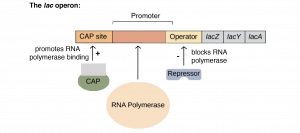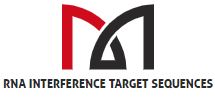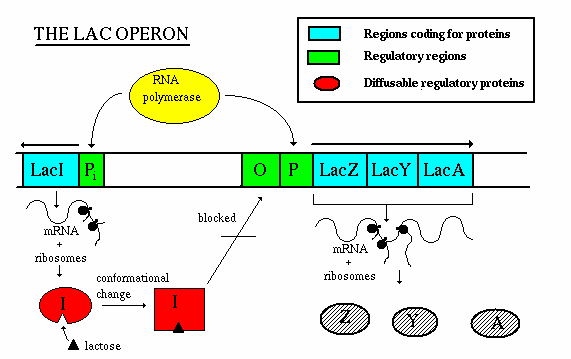Abstract
Bacteria use their genetic material very efficiently to make the right products in the right amounts at the right time. The study of bacterial transcription initiation in Escherichia coli has served as a model for understanding transcriptional control in bacteria. Every step in the pathway between gene and function is harnessed to exert this control, but for reasons of economy, it is clear that the key step to regulate is the initiation of RNA transcript formation.
The first insights into transcriptional regulation mechanisms came from studies of E. coli by researchers Francois Jacob and Jacques Monod. In E. coli and many other bacteria, the genes that code for several different proteins may be located in a single transcription unit called an operon. The genes in an operon share the same transcriptional regulation but are individually translated. Eukaryotes generally do not bundle genes as operons (the exception is C. elegans and a few other species).
The basic structure of the lac operon
E. coli finds many different sugars in its environment. These sugars, like lactose and glucose, require different enzymes for their metabolism. Three of the enzymes for lactose metabolism are clustered in the lac operon: lacZ, lacY, and lacA. LacZ encodes an enzyme called β-galactosidase, which digests lactose into its two constituent sugars: glucose and galactose.
lacY is a permease that helps transfer lactose into the cell. Finally, lacA is a trans-acetylase; whose relevance in the metabolism of lactose is not entirely clear. Transcription of the lac operon normally occurs only when lactose is available for digestion. Presumably, this avoids wasting energy on the synthesis of enzymes for which no substrate is present. A single mRNA transcript includes all three enzyme coding sequences and is termed polycistronic. A cistron is equivalent to a gene.
Cis and trans regulators
In addition to the three protein-coding genes, the lac operon contains short DNA sequences that do not code for proteins but are binding sites for proteins involved in transcriptional regulation of the operon. In the lac operon, these sequences are named P (promoter), O (operator), and CBS (CAP binding site). Collectively, sequence elements like these are called cis-elements because they must be located on the same piece of DNA as the genes they regulate. On the other hand, proteins that bind to these cis-elements are called trans regulators because (as diffusible molecules) they do not necessarily have to be encoded on the same piece of DNA as the genes they regulate.

lacI is an allosterically regulated repressor
One of the major trans regulators of the lac operon is encoded by lacI. Four identical molecules of lacI proteins assemble to form a homotetramer called a repressor. This repressor binds to two operator sequences adjacent to the promoter of the lac operon. Repressor binding prevents RNA polymerase from binding to the promoter. Therefore, the operon will not be transcribed when the operator is occupied by a repressor.
In addition to its ability to bind to specific DNA sequences in the operator, another important property of the lacI protein is its ability to bind lactose. When lactose binds to lacI, the shape of the protein changes in a way that prevents it from binding to the operator. Therefore, in the presence of lactose, RNA polymerase can bind to the promoter and transcribe the lac operon, leading to a moderate level of expression of the lacZ, lacY, and lacA genes. Proteins such as lacI that change their shape and functional properties after binding a ligand are said to be regulated through an allosteric mechanism.
CAP is an allosteric activator of the lac operon
A second aspect of regulation of the lac operon is conferred by a trans factor called cAMP-binding protein. CAP is another example of an allosterically regulated trans factor. Only when the CAP protein binds to cAMP can another part of the protein bind to a specific cis-element within the lac promoter called the CAP-binding sequence (CBS). CBS is located very close to the promoter (P). When CAP binds to CBS, RNA polymerase is better able to bind to the promoter and initiate transcription. Thus, the presence of cAMP ultimately leads to a further increase in the transcription of the lac operon.
The physiological importance of regulation by cAMP becomes more obvious in the context of the following information. The concentration of cAMP is inversely proportional to the abundance of glucose: when glucose concentrations are low, an enzyme called adenylate cyclase can produce cAMP from ATP. E. coli evidently prefer glucose to lactose and thus express the lac operon at high levels only when glucose is absent and lactose is present. This provides another layer of logical control of the expression of the lac operon: only in the presence of lactose, and in the absence of glucose, is the operon expressed at its highest levels.

